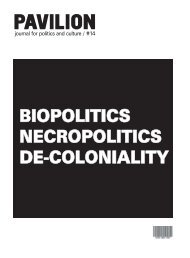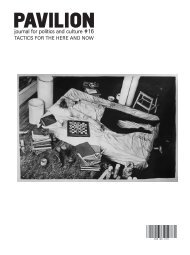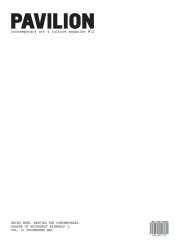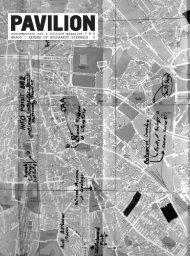PAVILION
PAVILION
PAVILION
- No tags were found...
Create successful ePaper yourself
Turn your PDF publications into a flip-book with our unique Google optimized e-Paper software.
tion of life which destroys all of its parameters<br />
of necessity; you will be lost in a<br />
labyrinth of animal figures, of human and<br />
divine vicissitudes, of natural and technical<br />
prostheses that fill every space in the<br />
narrative. That is what cognitive labour<br />
(and every mode of production linked to it)<br />
manages to do. Every mythical resonance<br />
that this doing had in Ovid has vanished.<br />
Consequently, in this disenchanted<br />
world in which we find ourselves we frequently<br />
come up against things which are,<br />
as it were, too real: this world of ours<br />
sometimes fills up with monsters, and we<br />
end up trembling. We would like this not<br />
to be true, but it is: that is the contemporary.<br />
We recognize this each and every<br />
time we deal with the monsters that our<br />
action and work produce and that relations<br />
of domination cause to proliferate.<br />
And the monster as we saw when we<br />
reflected on the reversibility which is<br />
always created in the relation between<br />
machinic subjects and objects the monster<br />
lives inside us, or is one of our prostheses,<br />
and it can turn back on us and<br />
partake in our metamorphosis. This is all<br />
the more reason for us to recognize the<br />
danger, every time we highlight the physical<br />
character of immaterial labour, the<br />
flesh of cognitive labour in brief, the common<br />
of life, the biopolitical, which constitutes<br />
us. Yet another paradox? Of course.<br />
In effect, moving within abstraction and<br />
immateriality, confronted by monsters, we<br />
are increasingly required to determine<br />
testing criteria that will have a bearing on<br />
corporeality that is, on the vital modalities<br />
of existential critique.<br />
Artistic production today<br />
The discovery that contemporaneity, and<br />
the mode of production that prevails within<br />
it, unfolds in danger, in contact with the<br />
monster, makes a reflection on the common<br />
obligatory: a decision on the sense<br />
[78]<br />
of being that is, on the direction that the<br />
event and the multitude must take in order<br />
to give meaning to the common. The aesthetic<br />
gesture (when it is interpreted in the<br />
form that we have done here) finds ethical<br />
decision on its path. We live in the midst<br />
of transformation, of the metamorphosis<br />
of space and time determined by the contemporary<br />
accumulation of work and civilization.<br />
Bodies are at stake within the<br />
process of transformation. Crises constantly<br />
break out which allow of no external<br />
solution. That is where we are, and we<br />
cannot go elsewhere. But we have this<br />
astonishing speech that we are capable<br />
of expressing, this creative capacity that<br />
we can put forward. By recapitulating the<br />
productive and the ontological, the event<br />
and the common, art thus could (perhaps<br />
it simply must) give ethical meaning to<br />
this predicament, helping us to construct<br />
that multiple paradigm in which being for<br />
the other, being in the common, triumphs.<br />
Can we draft prescriptions for a style that<br />
would be infused by an ethics? Asking<br />
oneself this is like asking oneself if it is<br />
once again possible to have access to a<br />
grand narrative on being. Or, better,<br />
whether it is possible to get close to a<br />
concrete utopia. I think so. And I would<br />
like to propose, coherently with what we<br />
have critically constructed up to this point,<br />
a three-stage approach, through which a<br />
style of artistic production may be defined<br />
today.<br />
The first stage consists in the immersion<br />
into the infinite movement of the bodies<br />
and events that surround us, from images<br />
of life to expressions of knowledge; or,<br />
better, to undertake that work of deconstruction<br />
of the real that immersion as<br />
such demands, when it is driven by a critical<br />
desire. Bare life and clothed life,<br />
poverty and wealth, critical desire and<br />
construction of the real this always constitutes<br />
the section of the diagram of immer-<br />
sion into true reality. We find ourselves<br />
partaking in the composition of the swarm<br />
of singularities. These singularities want<br />
to converge in the common while keeping<br />
their freedom.<br />
The second stage is reflexive. It presents<br />
itself as the moment of the recognition of<br />
the common. Here we act as a reconstituted<br />
swarm, not merely as a multitude<br />
but as a swarm that organizes the figures<br />
of flight and movement, the manner in<br />
which it is delineated as a viable and/or<br />
volatile direction, the materialist telos that<br />
surges up from below, from each and<br />
every one of its singularities. Thus the<br />
impoverished immersion (of the lone singularity)<br />
into the multiplicity of the swarm<br />
finds here the direction and cohesion of<br />
love. Through love that is, through that<br />
force which Spinoza saw as forming itself<br />
out conatus and cupiditas the solidarity of<br />
bodies and decisions of the spirit is constructed.<br />
A veritable metamorphosis thus<br />
takes place within the complex multiplicity<br />
that constructs the swarm.<br />
Immaterial labour has finally found an ethical<br />
legitimacy that is structurally bound to<br />
the way it reinvents itself as form of life.<br />
Art defines itself as form of life, characterized<br />
by poverty at its base, and by revolutionary<br />
will at the apex of the becomingswarm.<br />
We have now reached the third<br />
stage of this movement. Some time ago,<br />
Paolo Virno, anticipating many of the<br />
insights and concepts that were later<br />
expressed with respect to immaterial<br />
labour, defined the performances of this<br />
labour in terms of the masterwork (capolavoro).<br />
This hermeneutic anticipation by<br />
Virno should be given its due. But it<br />
should be developed further, once the<br />
homology between the formation of the<br />
multitudinous swarm and the operationality<br />
of immaterial labour (as well as cognitive<br />
and affective labour) is recognized.<br />
The common that has developed within<br />
artistic forms must now be embodied in a<br />
collective decision, in a common government.<br />
Or, better, it should be organized by<br />
a governance of/on/in the forms of life that<br />
have been constructed. The highpoint is<br />
to be found in this construction of the<br />
ethico-political limit of the common, in this<br />
internal government of agency; that is,<br />
when the experience of the common in<br />
opposition to any illusion of community<br />
expresses free and rich forms of life.<br />
To take up again the image of the beautiful<br />
which, as we recalled above, the<br />
Kantian schematism began to formulate,<br />
we could say that beyond a sublime that<br />
organizes itself at the limit of the mathematical<br />
infinite and a second model of the<br />
sublime that is elevated by the immensity<br />
of nature, there is a third model which<br />
hinges on ethical action, on the constitution<br />
of the multitudinous telos. This third<br />
model of the sublime takes shape at the<br />
limit constructed by amor (in Spinoza) as<br />
it completes the movement of cupiditas.<br />
The common as ethical sublime, the common<br />
as aesthetic sublime: against every<br />
spiritualist mystification there stands here<br />
that intersection of anthropogenesis and<br />
technogenesis identified by Stiegler and<br />
which we had considered with reference<br />
to the constitution and disclosure of the<br />
common.<br />
Translated by Alberto Toscan<br />
First published in Radical Philosophy 149<br />
(March/April 2008), translated<br />
here with permission.<br />
[79]








